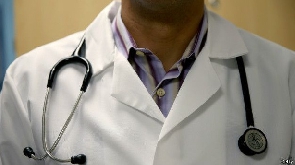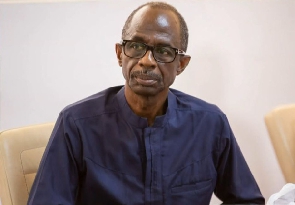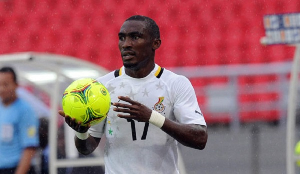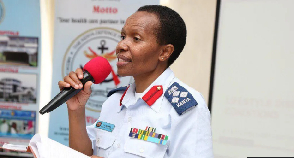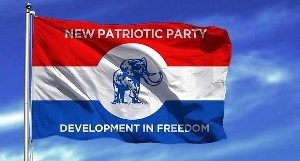Opinions of Tuesday, 19 March 2024
Columnist: Isaac Ato Mensah/Raphael Apetorgbor
Leaky Wave Antennas: Ghana born researcher leads Birmingham University team in search of millimitre-wave frequencies for 'remote vital sign detection'
Can you hear or feel your heartbeat on a regular day?
How about your baby’s heartbeat?
In rural Ghana and many rural countries, a funnel-shaped device is still used by traditional midwives to listen to the heart of a foetus where Doppler devices are not available.
A foetal Doppler machine, used in detecting the heartbeat of an unborn baby, costs about USD120 (roughly 1500 Ghanaian cedis).
Sad to say, many hospitals in Ghana only get some when they appeal for donations.
Learning from nature, scientists have always used the antenna to catch such signals.
But what if the signals are too muted, too silent, or there are other “noises” or interferences with your listening device?
This is the subject of enquiry of Dr Solomon Mingle, a Ghanaian born researcher in the UK.
Based on leaky wave radiation theory, Mingle used copper wires to create a “Dielectric Image Line” and successfully caught signals too small for regular healthcare devices such as Doppler machines to detect.
When the radiation signals are too small, scientists observe the bandwidth of such waves to be in millimetres, far smaller for other antenna technologies to detect.
What is more, the technology is designed for “remote vital sign monitoring (RVSM) in dynamic settings” says Mingle et al. (2022).
In a peer reviewed paper published in the Open Journal of Antennas and Propagation, Mingle et al. (2022) demonstrated that a prototype “antenna structure, housed in a low-loss polytetrafluoroethylene (PTFE) enclosure, facilitates practical mounting and measurement” and when placed at “the required height above the ground” there is no “interfering with radiation”.
Mingle et al. (2022) explained that “[t]he scanning range of the proposed antenna through the broadside is 70.19◦(−42.49◦to 27.7◦) with an impedance bandwidth of 15 GHz (50-65 GHz), an optimum gain in the fast wave area ranging from 15.5 dBi to 20.79 dBi and an efficiency of 83.8% at 57.5 GHz”.
The existential relevance of what Mingle et al. seek to do in researching remote vital signs measuring devices is not lost on us in Ghana.
Ditto for the Sustainable Development Goals (SDGs), especially Target 3.1 which aims to reduce the global maternal mortality ratio to less than 70 per 100 000 live births.
Apart from pregnant women who may not feel comfortable with the smear of jelly on their belly, there are numerous other situations whereby health workers may need to protect themselves from physical contact.
We all lived in fear of Ebola in West Africa.
As we all watched on CNN live in 2014, a healthcare worker who contracted the Ebola Virus Disease in West Africa was transported by air ambulance to America, then by road ambulance to Emory University in Georgia for treatment.
There was no bodily contact with the patient whatsoever during treatment.
Of course how could we forget the dreaded COVID-19? And scientists have warned that there are many more viruses with pandemic potential out there.
Thus is the need to “set sail” into the future of healthcare leadership as the motto of Pope John Secondary School has always inspired Mingle to do.
Solomon Mingle, was born in Accra and named Solomon Adotey Mingle. His father was from Osu, hence the surname Mingle, a typical Osu name. Mingle’s father worked at the Ghana Meteorological Agency, so perhaps measuring devices has always inspired him from there.
Solo Mingle read Higher National Diploma (HND) in Industrial Laboratory Technology at Accra Polytechnic.
From there, he went to the UK and worked in police forensic laboratories. By dint of hard work, he received a Master degree in communications engineering and networks from the University of Birmingham in the UK in 2019. And in 2022, he successfully went through a viva voce defence for a PhD in quantum wireless communications and sensors.
Dr Mingle has always rued education in Ghana. Back in his heydays - and still - it was difficult to transition from an HND straight to a masters programme.
The University of Birmingham, therefore, deserves kudos for helping Dr Mingle achieve his potential.
Dr Mingle is supported at Birmingham by his research colleagues Despoina Kampouridou and Alexandros Feresidis, a Member and Senior Member respectively of the Institute of Electrical and Electronics Engineers.
It is early days yet to measure the industrial significance of the yeoman's job done by Mingle et al.
But technologies are already being adopted and incorporated into many devices for healthcare so why not hype one of our own - now?

